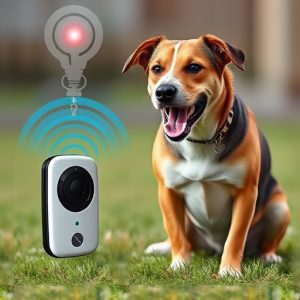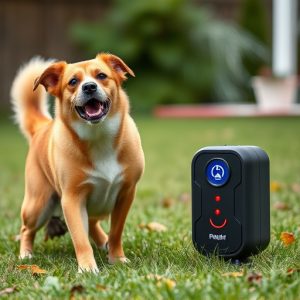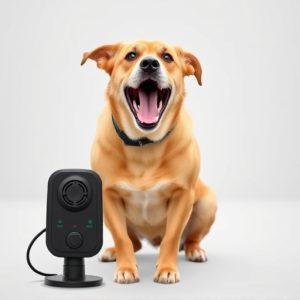Prevent Dog Attacks: Handheld vs Wall-Mounted Ultrasonic Repellents
Dogs' natural instincts and lack of socialization can lead to unexpected aggression towards ele…….
Dogs' natural instincts and lack of socialization can lead to unexpected aggression towards electronic devices, especially handhelds and wall-mounted ultrasonic repellents. These repellents, using high-frequency sound waves, are popular solutions, with handheld devices offering portability for outdoor use and wall-mounted options providing continuous protection. Choosing between them depends on personal needs: handhelds for convenience or wall-mounted units for permanent barriers. Effective prevention also involves dog training and positive reinforcement to reduce aggression towards electronic devices in public spaces.
In recent years, dog attacks on electronic devices have become a growing concern. This phenomenon, often driven by curiosity or fear, highlights the need for effective solutions. This article delves into understanding dog aggression towards electronics and explores two prominent methods to deter them: handheld and wall-mounted ultrasonic repellents. We compare their pros and cons, offering insights for dog owners. Additionally, practical training and prevention strategies are discussed to foster a harmonious co-existence between pets and technology.
- Understanding Dog Aggression Towards Electronic Devices
- The Science Behind Ultrasonic Repellents: Handheld vs Wall Mounted
- Pros and Cons of Each Repellent Type for Dog Owners
- Training and Prevention Strategies to Avoid Dog Attacks on Electronics
Understanding Dog Aggression Towards Electronic Devices
Dogs, known for their loyalty and companionship, can sometimes exhibit unexpected aggression towards electronic devices. This behavior is often rooted in their natural instincts or lack of socialization. When a dog perceives a handheld device or even a wall-mounted ultrasonic repellent as a potential threat or an object to play with, it might react aggressively. The small, moving screens and sudden noises can stimulate their senses, leading to nips or bites.
Understanding this aggression is the first step towards prevention. Handheld devices, with their portability and personal association, can be especially enticing for dogs. In contrast, wall-mounted ultrasonic repellents, while effective, might not be as intuitive to a dog’s understanding. Training plays a crucial role; teaching dogs to associate these devices with positive experiences rather than negative ones can significantly reduce aggressive tendencies.
The Science Behind Ultrasonic Repellents: Handheld vs Wall Mounted
Ultrasonic repellents have emerged as a popular solution to deterring dog attacks on electronic devices, leveraging sound waves to create an invisible barrier. The science behind these devices is based on emitting high-frequency sound pulses that are inaudible to humans but irritating to dogs. When a dog approaches the source of these ultrasonic waves, they react with discomfort or fear, typically turning away and avoiding the area.
There are two primary types: handheld and wall-mounted. Handheld devices offer portability, allowing users to carry them wherever needed, which is ideal for outdoor activities or traveling with pets. On the other hand, wall-mounted units provide a more permanent solution, ensuring continuous protection without the need for constant handling. The choice between these depends on personal preference and usage scenarios.
Pros and Cons of Each Repellent Type for Dog Owners
Dog attacks on electronic devices can be a significant concern for owners, leading many to explore various repellent options. Two prominent types are handheld and wall-mounted ultrasonic repellents. The former offers convenience, allowing owners to carry it easily and use it at any time or place. This portable nature makes it ideal for outdoor activities, ensuring protection on walks or in gardens. However, handheld devices might require frequent recharging, and their effectiveness can be affected by the user’s proximity and consistency of usage.
On the other hand, wall-mounted ultrasonic repellents provide a more permanent solution. These devices are strategically placed at entry points or problem areas, emitting high-frequency sound waves that are unpleasant to dogs but harmless to humans and pets. While they lack the portability of handheld options, they offer continuous protection and can be less noticeable, making them suitable for indoor and outdoor use in homes and offices. However, installation costs and the need for regular maintenance should be considered before choosing this method.
Training and Prevention Strategies to Avoid Dog Attacks on Electronics
Dog attacks on electronic devices, especially in public spaces, are a growing concern. Training and prevention strategies are essential to mitigate this issue. One effective method is introducing ultrasonic repelents—handheld or wall-mounted devices that emit high-frequency sound waves, which dogs find unpleasant. These non-lethal solutions can be easily carried by individuals or installed in public areas without causing harm to animals.
Training plays a significant role in preventing such incidents. Dog owners should teach their pets basic commands and positive reinforcement techniques to ensure they remain calm in the presence of unfamiliar devices or people. Regular exposure to different stimuli, including electronic gadgets, can help dogs become more accustomed and less reactive. This proactive approach combines technological deterrents with responsible ownership practices for a safer environment.
In conclusion, understanding dog aggression towards electronic devices is the first step to preventing attacks. Both handheld and wall-mounted ultrasonic repelents offer solutions, each with its own set of pros and cons. Handheld devices are convenient for travel or on-the-go protection, while wall-mounted options provide continuous coverage in fixed locations. Training and prevention strategies, such as positive reinforcement and setting boundaries, are also effective tools to foster a peaceful coexistence between pets and technology. By choosing the right repellent and implementing training techniques, dog owners can create a safer environment for both their furry companions and their electronic devices.


